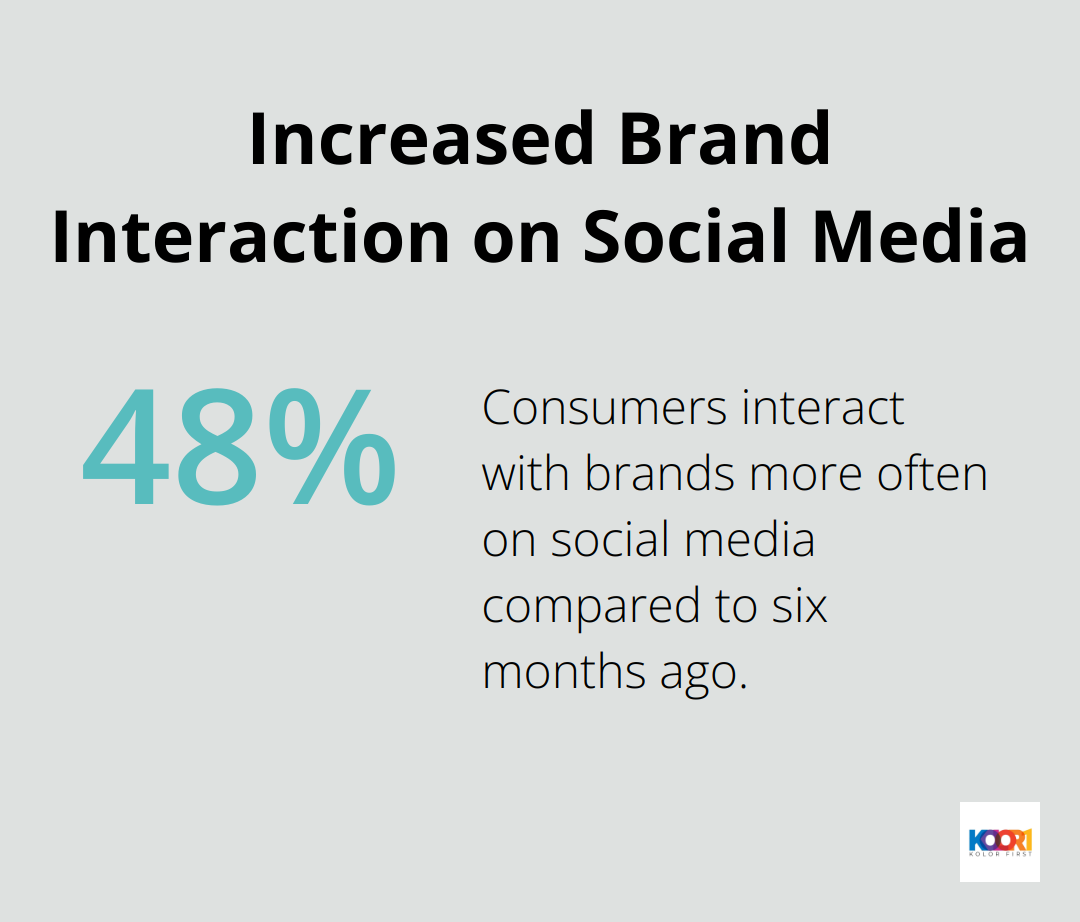Digital marketing has become a game-changer for small businesses. At Kolorfirst LLC, we’ve seen firsthand how effective online strategies can level the playing field, allowing smaller companies to compete with industry giants.
This blog post will guide you through proven digital marketing techniques tailored for small businesses. We’ll cover everything from developing a solid strategy to leveraging social media and optimizing your website for search engines.
How to Create a Winning Digital Marketing Strategy
Know Your Audience Inside Out
A solid digital marketing strategy forms the foundation of online success for small businesses. The first step is to set clear goals and objectives that are essential to your business. You need to understand your audience thoroughly. Use tools like Google Analytics and social media insights to collect data on your customers’ demographics, interests, and online behavior. This information will guide your marketing efforts and help you create content that resonates with your target market.
Select the Right Digital Channels
After you understand your audience, choose the most effective digital marketing channels. Don’t try to be everywhere. Focus on platforms where your audience is most active. For instance, if you target professionals, LinkedIn might be your go-to platform. If you’re a visual brand targeting younger audiences, Instagram and TikTok could be your best bets.
Set a Realistic Budget and Timeline
Small businesses must set a realistic budget and timeline. Start small and scale up as you see results. Allocate your resources based on the potential return on investment of each channel. For example, if email marketing consistently drives sales, it might deserve a larger portion of your budget than other channels.
Measure Success with KPIs
To assess the effectiveness of your strategy, establish clear key performance indicators (KPIs). These could include website traffic, conversion rates, social media engagement, or email open rates. Tools like Google Analytics and social media analytics platforms can help you track these metrics. Review your KPIs regularly and adjust your strategy based on what the data tells you.
A successful digital marketing strategy requires constant monitoring and tweaking. Small businesses can achieve remarkable growth by staying flexible and responsive to market changes and customer feedback. Real-life examples show how small businesses have overcome challenges and achieved tangible results. Follow these steps and remain adaptable to craft a digital marketing strategy that drives real results for your small business.
Now that you’ve laid the groundwork for your digital marketing strategy, it’s time to explore one of the most powerful tools in your arsenal: social media. In the next section, we’ll discuss how to leverage various social platforms to boost your small business growth and engage with your target audience effectively.
How Social Media Can Boost Your Small Business
Social media has become a powerhouse for small business growth. Let’s explore how you can harness this potential for your business.
Choose the Right Platforms
Not all social media platforms will work for your business. Focus on where your target audience spends their time. For B2B companies, LinkedIn often proves the most effective. If you target younger consumers, Instagram and TikTok might yield better results. Facebook remains a solid choice for many small businesses due to its broad user base and robust advertising options.
Nearly half (48%) of consumers said they interact with brands more often on social media than six months ago. However, it’s better to excel on one or two platforms than to spread yourself thin across all of them. Start with the platforms most relevant to your audience and expand as you grow.

Create Content That Resonates
After you’ve chosen your platforms, create content that engages your audience. According to HubSpot, 54% of consumers want to see more video content from brands they support. Try to incorporate short-form videos, live streams, or behind-the-scenes content to give your audience a peek into your business.
User-generated content (UGC) is another powerful tool. Encourage customers to share photos or videos of your products in use. This not only provides social proof but also helps build a community around your brand. Airbnb’s Instagram feed, for example, consists almost entirely of user-generated content, showcasing unique stays from around the world.
Leverage Social Advertising
While organic reach matters, paid social media advertising can significantly boost your visibility. Facebook’s advertising platform offers highly targeted options, allowing you to reach specific demographics, interests, and behaviors. Start with a small budget and test different ad formats to see what resonates with your audience.
According to WordStream, the average click-through rate for Facebook ads across all industries is 0.90%. If you see rates higher than this, you’re on the right track. If not, you might need to refine your targeting or ad creative.
Build a Community
Social media isn’t just about broadcasting your message; it’s about building relationships. Respond promptly to comments and messages.
Consider creating a Facebook Group for your most engaged customers. This can serve as a space for community building, customer support, and even product feedback. Peloton’s Official Member Page on Facebook exemplifies how a brand can foster a sense of community among its users.
Social media success requires consistent effort, authentic engagement, and a willingness to adapt based on what resonates with your audience. As you implement these strategies to boost your social media presence, you’ll also need to ensure that your website is optimized for search engines. In the next section, we’ll explore how to improve your website’s visibility and attract more organic traffic.
How to Optimize Your Website for Search Engines
Search engine optimization (SEO) plays a vital role in any successful digital marketing strategy. It can significantly increase organic traffic and lead generation for small businesses. Let’s explore how to enhance your website’s visibility and attract more organic traffic.
Master Keyword Research and On-Page SEO
The foundation of SEO lies in understanding what your target audience searches for. Tools like Google Keyword Planner or SEMrush help identify high-traffic, relevant keywords. Once you’ve identified your target keywords, strategically incorporate them into your website’s content, meta descriptions, title tags, and headers.
This guide will walk you through some of the most common and effective improvements you can do on your site.
Avoid keyword stuffing. Search engines now understand context and user intent. Focus on creating natural, informative content that addresses your audience’s needs.
Create Valuable, SEO-Friendly Content
Content reigns supreme in the world of SEO. Publish high-quality, original content regularly that provides value to your audience. This could include blog posts, how-to guides, or industry insights.
Organize your site, use descriptive URLs, group topically similar pages in directories, and reduce duplicate content.
Include relevant images, videos, and infographics to make your content more engaging and shareable. Optimize these elements with descriptive file names and alt text.
Boost Website Speed and Mobile Responsiveness
Website loading speed and mobile responsiveness significantly impact search rankings. Google’s PageSpeed Insights tool helps identify areas for improvement. Simple steps like compressing images, minifying CSS and JavaScript, and leveraging browser caching can improve your site’s speed dramatically.
With mobile devices accounting for over 50% of global web traffic, a mobile-friendly website is non-negotiable. Use Google’s Mobile-Friendly Test to check your site’s mobile performance.

Build Quality Backlinks
Backlinks from reputable websites signal to search engines that your content is valuable and trustworthy. Earn high-quality backlinks through guest posting, creating shareable content, and engaging in your industry’s online communities.
Quality trumps quantity in link building. A single backlink from a high-authority site in your industry can outweigh dozens of links from low-quality sources. Avoid buying links or participating in link farms (these tactics can result in penalties from search engines).
Final Thoughts
Digital marketing empowers small businesses to compete and thrive in today’s market. A solid strategy, effective social media use, and optimized websites can significantly boost online presence and attract more customers. Success in digital marketing requires consistent effort, continuous learning, and adaptability to changing trends and technologies.
Small businesses should start with one or two channels that align with their goals and gradually expand efforts as they see results. We at Kolorfirst LLC have witnessed how digital marketing transforms small businesses. Our team creates innovative branding and marketing solutions tailored to unique needs.
Small businesses must seize the opportunities digital marketing offers. Implementation of these strategies can help achieve measurable growth and stand out in a competitive market. Take the first step today and watch your small business reach new heights through the power of digital marketing.






